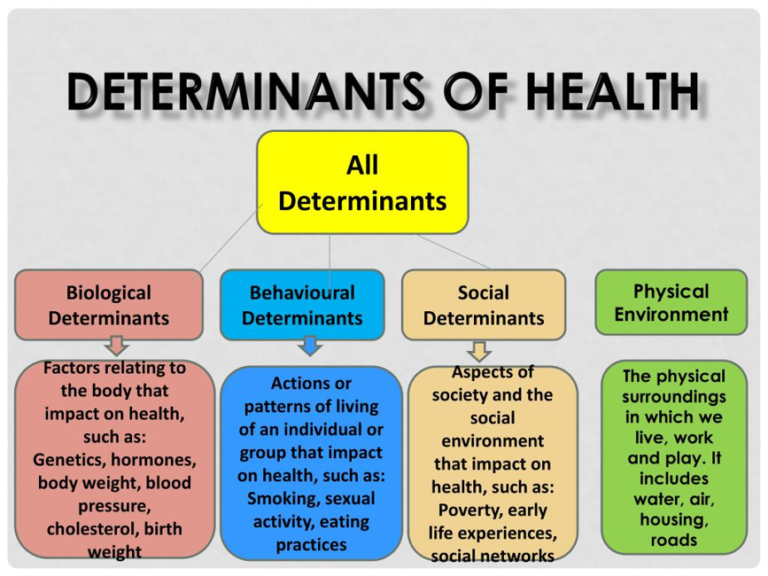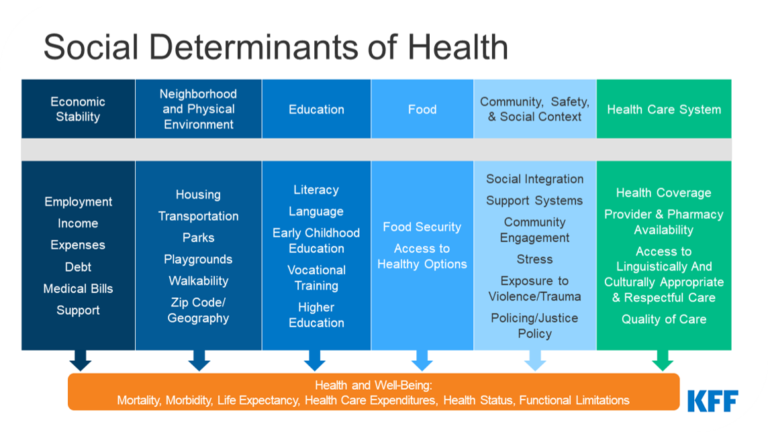- There are many factors that combine together to affect the health of individuals and communities.
- Whether people are healthy or not, is determined by their circumstances and environment.
- To a large extent, factors such as where we live, the state of our environment, genetics, our income and education level, and our relationships with friends and family all have considerable impacts on health.
- Individuals are unlikely to be able to directly control many of the determinants of health.
Determinants of Health
- The social and economic environment,
- The physical environment, and
- The person’s individual characteristics and behaviors.
- The biological or genetic determinants.

Social and Economic factors
- Social determinants of health reflect the social factors and physical conditions of the environment in which people are born, live, learn, play, work, and age. Also known as social and physical determinants of health, they impact a wide range of health.
- Examples of social determinants include:
- Availability of resources to meet daily needs, such as educational and job opportunities, living wages, or healthy foods
- Social norms and attitudes, such as discrimination.
- Social support networks – greater support from families, friends and communities is linked to better health. Culture – customs and traditions, and the beliefs of the family and community all affect health.
- Income and social status – higher income and social status are linked to better health. The greater the gap between the richest and poorest people, the greater the differences in health
- According to the latest survey, SDOH accounts for 80% of health outcomes and medical factor only determine 10%
- According to WHO, SDOH is the non medical factor that play a direct role in deciding a person’s overall health.
- The social determinants of health are the condition in which you were born, live, grow, work and the other environmental determinants and social gradients.
- These conditions make up the quality of life; the better the quality of life, the better is the health outcome.

Physical Environment
- Physical environment – safe water and clean air, healthy workplaces, safe houses, communities and roads all contribute to good health. Employment and working conditions – people in employment are healthier, particularly those who have more control over their working conditions.
Physical determinants of health
- You might think physical determinants of health refer to a person’s activity level. You’d be wrong. They’re factors in a person’s physical environment that impact them. Examples of physical determinants of health include:
- Natural environment, such as plants, weather or climate change
- Built environment, such as buildings or transportation
- Worksites, schools and recreational settings
- Housing, homes and neighborhoods
- Exposure to toxic substances and other physical hazards
- Physical barriers, especially for people with disabilities
- Aesthetic elements, such as good lighting, trees or benches
Person’s individual characteristics and behavior
What are individual behaviors?
Individual behavior can be defined as a mix of responses to external and internal stimuli. It is the way a person reacts in different situations and the way someone expresses different emotions like anger, happiness, love, etc.
Individual Behavior
- Individual behavior also plays a role in health outcomes. For example, if an individual quits smoking, his or her risk of developing heart disease is greatly reduced.
- Many public health and health care interventions focus on changing individual behaviors such as substance abuse, diet, and physical activity. Positive changes in individual behavior can reduce the rates of chronic disease in this country.
Examples of individual behavior determinants of health include:
- Diet
- Physical activity
- Alcohol, cigarette, and other drug use
- Hand washing
| Physical | Psychological | Socio-cultural |
|---|---|---|
| Gender | Personality traits | Family background |
| Age | Motivation | Religion |
| Physical Abilities | Attitude | Socio-economic status |
| Physique | Perceptions | Education |
| Health state | Mental abilities | Peer pressure/work culture |
Biological and Genetic factors
- Genetics – inheritance plays a part in determining lifespan, healthiness and the likelihood of developing certain illnesses. Personal behavior and coping skills – balanced eating, keeping active, smoking, drinking, and how we deal with life’s stresses and challenges all affect health.
- Health services – access and use of services that prevent and treat disease influences health.
- Gender – Men and women suffer from different types of diseases at different ages.
- Some biological and genetic factors affect specific populations more than others. For example, older adults are biologically prone to being in poorer health than adolescents due to the physical and cognitive effects of aging.
- Sickle cell disease is a common example of a genetic determinant of health. Sickle cell is a condition that people inherit when both parents carry the gene for sickle cell.
Examples of biological and genetic social determinants of health include:
- Age
- Sex
- HIV status
- Inherited conditions, such as sickle-cell anemia, hemophilia, and cystic fibrosis
- Carrying the BRCA1 or BRCA2 gene, which increases risk for breast and ovarian cancer
- Family history of heart disease.
Health Services
- Both access to health services and the quality of health services can impact health.
- Lack of access, or limited access, to health services greatly impacts an individual’s health status. For example, when individuals do not have health insurance, they are less likely to participate in preventive care and are more likely to delay medical treatment.
Barriers to accessing health services
- Lack of availability
- High cost
- Lack of insurance coverage
- Limited language access
These barriers to accessing health services lead to:
- Unmet health needs
- Delays in receiving appropriate care
- Inability to get preventive services
- Hospitalizations that could have been prevented.
Indicators of Health
- A health indicator which will be used internationally to describe global health should have the following characteristics:
- It should be defined in such a way that it can be measured uniformly internationally.
- It must have statistical validity.
- The indicator must be data which can feasibly be collected.
- The analysis of the data must result in a recommendation on which people can make changes to improve health.
List of Health indicators
MORTALITY INDICATORS: the state of being subjected to death.
- Crude death rate
- Life expectancy
- Infant mortality rate
- Maternal mortality rate
MORBIDITY INDICATORS: the condition of suffering from disease.
- Prevalence
- Incidence
- Others
Health status
Incidence counts of any of the following in a population may be health indicators:
- Low birth weight
- Obesity
- Arthritis
- Diabetes
- Asthma
- High blood pressure
Disability indicators
- Disability adjusted life years (DALY)
- Others: Activities of daily living (ADL), Musculoskeletal disability (MSD) score etc.
Nutritional indicators
- Proportion of low birth weight
- Prevalence of anemia
- Proportion of overweight individuals
- Nutritional intake assessments.
Social and mental health indicators
- Alcohol related indicators
- Injury rates
Health system indicators
- Healthcare delivery related
- Health policy indicators
Conclusion
- The health standards can be dependent on how our health is affected according to different health determinants and different health indicators.
- Health determinants are the range of behavioural, biological, socio-economic and environmental factors that influence the health status of individuals or populations
- A Health indicator is a characteristic of an individual, population, or environment which is subject to measurement (directly or indirectly) and can be used to describe one or more aspects of the health of an individual or population (quality, quantity and time).
- Our health in our hand and it will be controlled by various health standards.

